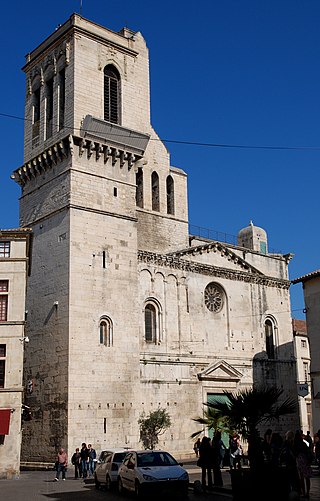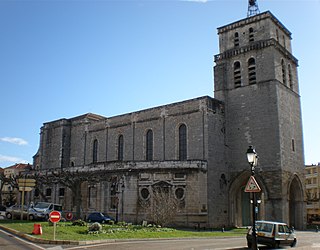Castor most commonly refers to:
Vincent of Lérins was a Gallic monk and author of early Christian writings. One example was the Commonitorium, c. 434, which offers guidance in the orthodox teaching of Christianity. Suspected of semi-Pelagianism, he opposed the Augustinian model of grace and was probably the recipient of Prosper of Aquitaine's Responsiones ad Capitula Objectionum Vincentianarum. His feast day is celebrated on 24 May.

Nîmes is the prefecture of the Gard department in the Occitanie region of Southern France. Located between the Mediterranean Sea and Cévennes, the commune of Nîmes has an estimated population of 148,561 (2019).
Semi-Pelagianism is a Christian theological and soteriological school of thought about the role of free will in salvation. In semipelagian thought, a distinction is made between the beginning of faith and the increase of faith. Semi-Pelagian thought teaches that the latter half – growing in faith – is the work of God, while the beginning of faith is an act of free will, with grace supervening only later. Semi-Pelagianism in its original form was developed as a compromise between Pelagianism and the teaching of Church Fathers such as Saint Augustine. Adherents to Pelagianism hold that people are born untainted by sin and do not need salvation unless they choose to sin, a belief which had been dismissed as heresy. In contrast, Augustine taught that people cannot come to God without the grace of God. Like pelagianism, semipelegianism was labeled heresy by the Western Church at the Second Council of Orange in 529.

Apt is a commune in the Vaucluse department in the Provence-Alpes-Côte d'Azur region in southeastern France.

Sep. 1 - Eastern Orthodox liturgical calendar - Sep. 3

John Cassian, also known as John the Ascetic and John Cassian the Roman, was a Christian monk and theologian celebrated in both the Western and Eastern churches for his mystical writings. Cassian is noted for his role in bringing the ideas and practices of early Christian monasticism to the medieval West.

Lérins Abbey is a Cistercian monastery on the island of Saint-Honorat, one of the Lérins Islands, on the French Riviera, with an active monastic community.

The Diocese of Gap and Embrun is a Latin Church ecclesiastical territory or diocese of the Catholic Church in Provence-Alpes-Côte d'Azur region of Southern France.

The Diocese of Fréjus–Toulon is a Latin diocese of the Catholic Church in southeastern France on the Mediterranean coast. The present diocese comprises the territory of the ancient Diocese of Fréjus as well as that of the ancient Diocese of Toulon. In 1957 it was renamed as the Diocese of Fréjus–Toulon.

The Abbey of Saint-Victor is a former abbey that was founded during the late Roman period in Marseille in the south of France, named after the local soldier saint and martyr, Victor of Marseilles.
Saint Leontius was a bishop of Fréjus, in Provence. He was probably born at Nîmes, towards the end of the fourth century; he died in his episcopal town in 488, according to some authorities, though others say 443 or 448. His feast day is 1 December.
Saint Castor may refer to:

Nîmes Cathedral is a Roman Catholic church in Nîmes, France. The cathedral is dedicated to the Blessed Virgin Mary and to the local Saint Castor of Apt.

The Diocese of Nîmes is a Latin diocese of the Catholic Church in France. The diocese comprises all of the department of Gard. It is a suffragan of the Diocese of Avignon.

The former French Catholic diocese of Alais was created in 1694, out of territory previously part of the diocese of Nîmes. It was suppressed after the French Revolution, with its territory being divided between the diocese of Avignon and the diocese of Mende. Its seat was Alès Cathedral.

The former French Catholic diocese of Apt, in southeast France, existed from the fourth century until the French Revolution. By the Concordat of 1801, it was suppressed, and its territory was divided between the diocese of Digne and the diocese of Avignon. Its seat was at Apt Cathedral, in Vaucluse.
Alain (II) de Coëtivy was a prelate from a Breton noble family. He was bishop of Avignon, Uzès, Nîmes and of Dol, titular cardinal of Santa Prassede, then cardinal-bishop of Palestrina and cardinal-bishop of Sabina. Many sources mention him as the Cardinal of Avignon.
Saint Cassian of Autun was a 4th-century bishop of Autun. He may have been an Egyptian by birth. He traveled to Autun and was a follower of Saint Reticius, bishop of Autun.
Faustin was the fifth bishop of Lyon. He is venerated as a saint within the Catholic Church.












